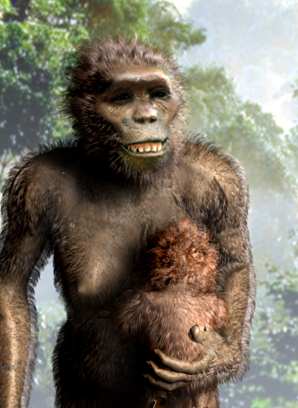The field of paleoanthropology and the evolution of man is more fraught with controversy among its proponents than probably any other field of evolutionary studies. The majority of paleoanthropologists believe that Australopithecus afarensis is on the main evolutionary line (or very close to it) heading toward modern humans.
Three Israeli scientists have reported in the most recent issue of the Proceedings of the National Academy of Science1 that Au. afarensis may not be our ancestor at all. It all hinges on the jaw of these creatures (pardon the pun). Alas, Au. afarensis has a lower jaw bone (mandible) that closely resembles that of a gorilla—not that of a human or even a chimp. The scientists conclude that this “cast doubt on the role of Au. afarensis as a modern human ancestor.”
This should not come as a huge surprise, since even Donald Johanson, the discoverer of the first Au. afarensis “Lucy,” conceded that its V-shaped mandible was very ape-like, and certainly nothing like that of a human.2
The part of the mandible that sweeps up from the angle of the jaw and hinges with the skull is known as the “ramus.” In all primates, the superior end of the ramus ends in two processes: the more anterior coronoid process (which attaches to the temporalis, a chewing muscle), and the posterior condylar process (which articulates with a shallow socket in the base of the skull). The two processes are separated by an indentation of the ramus known as the “mandibular notch.”
The shape of the ramus is species-specific among certain groups of primates. The human ramus is similar to that of a chimp and orangutan, as well as that of several other primates, while that of Au. afarensis is similar to gorillas. In the case of humans and many other primates, the coronoid process of the ramus is relatively slender (particularly at its tip), shorter in height than the condylar process, and the two processes are separated by a deep mandibular notch. The mandibular ramus of Au. afarensis, however, is similar to the gorilla in that the coronoid process is broad out to its tip and is separated from the condylar process with a shallow mandibular notch.
The authors focus on the presumed evolutionary implications of the shape of the coronoid process, but its shape tells us less about evolution than about the function of this bony process. Gorillas have massive temporalis muscles giving them a very powerful chewing force. The strong pulling force of this large muscle on the coronoid process to which it is attached results in a massive development of this bony attachment. One must assume that Au. afarensis also had a large temporalis muscle and engaged in some heavy chewing.
Much is made of the similarity of mandibular ramus of the human and chimp because it supports the purported close evolutionary relationship of humans and chimps. But this is not compelling because many other more distantly “related” primates also have a mandibular ramus similar to humans.
Of interest is the observation that the mandibular ramus of Au. afarensis closely resembles that of the primate fossil Au. boisei as well as that of the gorilla. Although Au. boisei is not currently considered to be an ancestor of man, it once was considered to be ancestral under a different name.
Louis Leakey first made his reputation with the discovery of “Zinjanthropus,” commonly known as “East Africa Man” or “Nutcracker Man.” In the 60s and 70s, many school children memorized the names of this ape as a “known ancestor” of man. Zinjanthropus is essentially the same primate later known as Au. boisei. None of these robust australopithecines are now considered to be ancestral to man.
So it appears that Au. afarensis (“Lucy”) joins Au. boisei as a non-ancestor of man. One wonders what they will now do with the Laetoli footprints that are generally believed by evolutionists to have been made by Au. afarensis and also serve as compelling proof that “Lucy” walked upright and was a human ancestor.
We may be certain that the human evolution scenario will continue to change regularly; only the confidence that man did evolve from apes will go unchanged. As the evolutionist Michael Lemonick said in an article in Timemagazine3 titled “How Man Began”: “The only certainty in this data-poor, imagination-rich, endlessly fascinating field is that there are plenty of surprises left to come.” The question is if there is any real empirical science left to come in this data-poor, imagination-rich field of evolutionary speculation.







